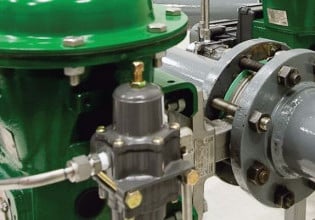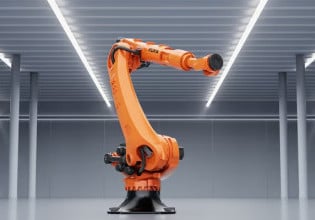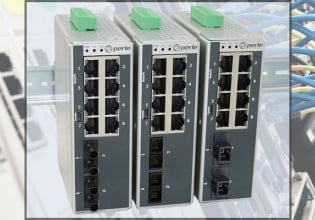Introduction to Sequence Valve Control in Fluid Flow Systems
Fluid flow control is often crucial to control systems and can be achieved by incorporating control valves. In this article, we will look at the sequence valve and its use in systems to automate fluid flow.
The growth and maintenance of sustainable flows in production industries have become an area of focus in treatment and industrial production facilities in recent years. Whether the industry involves paper pulp, wastewater, or even food processing, there has been a lot of interest in ensuring more reliable operations. The development of better valves has enabled industries to achieve accurate and precise flow control.
One such valve is the sequencing valve. This article will define sequence valves and how they are used compared to standard control valves.

Figure 1. Sequence control valves are designed to control two or more operations in sequence.
What Is a Sequence Valve?
Sequence valves, or sequencing valves, are special valves used for flow control in fluid systems such as pneumatics and hydraulics. These types of valves control the order of operations executed in the power system. They ensure that specified fluid flow actions follow in the proper predetermined sequence to achieve expected and desired outcomes. In other words, they control two or more operations in sequence, one after the other.
For example, executions such as one cylinder extending, then a second cylinder following after the first cylinder has completed the extension. Instead of using several limit switches and directional control valves to control two actuators moving in sequence, a single sequence valve serves this purpose. Using a sequence valve makes the operation safe and economical. It also reduces the number of components tied to the system, making maintenance easy compared to the inclusion of limit switches and multiple directional control valves used in the process.

Figure 2. Structure of the sequencing valve. Image provided by author
Sequencing Valve Structure
As shown in Figure 1, the sequencing valve is made up of the adjusting screw, conical poppet, and the spring mounted inside the valve enclosure. The valve has a single inlet labeled ‘inlet port’ and two outlet ports labeled ‘1’ and ‘2’. Outlet 1 is connected to cylinder 1, and outlet 2 is connected to cylinder 2.

Figure 3. Sequencing valve structure with a checking valve connection. Image provided by author
How Do Sequence Valves Work?
On supplying the working fluid to the sequencing valve inlet port, the fluid flows directly to outlet port 1, triggering cylinder 1 to extend.
Once cylinder 1 completes the extension, the pressure will increases in the line. This causes the lifting of the sequence valve poppet from its initial resting point, allowing the working fluid to flow through port 2 and thus extending cylinder 2. Through this process, sequencing is achieved.
It is good to take note that port 1 can allow reversing the flow of the working fluid, but port 2 cannot, so it’s possible to retract the first cylinder but impossible for the second cylinder. Therefore, a check valve is incorporated to allow working fluid free flow from the connected cylinder 2 back to the reserve tank, allowing retraction of the connected second cylinder.

Figure 4. Hydraulic (Left) and pneumatic (Right) sequence valve structure and symbols (click to enlarge). Image used courtesy of Statewide Hydraulics
Types of Sequencing Valves
Here our focus is on both the hydraulic and the pneumatic sequence valves. Most hydraulic sequence valves are designed for a single purpose; thus, a directional control valve is introduced in series. In contrast, most pneumatic sequence valves function through pilot-operated directional control mode, where an adjustable return spring is used to pull the cylinder back to its initial position.
Pilot-operated sequence are valves offered by many manufacturers, usually operated within 50 psi of the overall set pressure.
Types of sequence valves include the following:
Direct Acting Valve
As explained in the previous diagrams, a direct acting sequence valve is a spool-type valve with a spring structure that keeps the spool in a closed position. It has an adjustable pressure spring settings that, when exceeded by the inlet pressure, the spool shifts the fluid flow to the second operation. The valve finds use in areas involving constant and low-pressure flows.
Unloader Valve
Unloader valves work only when there is enough pressure created at 1. With enough pressure at 1, the flow in 2 will be initiated—sufficient pressure at 1 forces the poppet to open and create a flow path from 2 to 3. If there is a drop in pressure at 1 to a value below the product of the pilot ratio and predetermined settings of the spring, the valve closes, and this blocks the flow at 2. Such valves find use in unloading pump outlets to tanks at a low-pressure drop, hence delivering high efficiency of the system.
Pilot Operated Valve
A pilot operated sequence valve is made up of the external drain and the internal pilot. The pressure at the inlet triggers the pilot seat, causing the ball to pull back, extending the spring and opening the flow into the tank through a well-designed drain port. Immediately, the flow goes through the orifice stationed at the system’s main spool, and a pressure imbalance is initiated, which makes the spool press the spring back to the initial position. This valve type finds use in flow and higher pressure varying.
Kick Down Valve
Kick down sequence valves operate in a way that blocks the flow at port 1 until enough pressure is built to push the pilot poppet from its resting point. This valve’s operation is exactly similar to that of the pilot-operated sequence valve. Kick down sequence valves are used as safety devices in automation circuits involving overheating and overloading challenges arising from pressure being held in a system for a longer time.

Figure 5. Pressure sequence valves can replace two limit switches and two directional control valves by running double sequencing actuators. Image used courtesy of Festo
Sequence Valve Features and Benefits
Features and benefits of sequencing valves include:
- An activated flow, thus a drop ball is not needed.
- The valve is normally open, and this allows annulus circulation.
- The closing differential pressure field adjustment is very simple.
- Suitable for gas and fluid applications.
Why Use Sequence Valves?
Below is a list of the advantages and disadvantages of using sequence valves in automation.
Advantages
- Sequence valves are good at providing operations in sequence series, for example, in a lift and clamp circuit.
- In systems involving varying or high back pressure, sequence valves are incorporated as relief valves.
- The valve ensures that the fluid flow occurs in a predetermined sequential manner.
Disadvantages
- The valve tends to generate excessive heat.
- The first moved actuator receives higher pressure as compared to the second actuator. This means the second actuator to move receives less pressure, meaning some energy is wasted in such valves.
Pressure Sequence Valves in Fluid Flow
There is a lot of information concerning sequence valves that cannot be covered in a single article. The involvement of this type of valve in fluid flows in industries such as waste management, beverages, oil refineries, etc.
Sequence valves can be of great use, and their incorporation with PLC-controlled systems improves automation and fluid flow control. Their incorporation reduces the cost of a single sequence valve, replacing multiple limit switches and directional control valves to run double sequencing actuators. Such a valve makes maintenance easier since it reduces the number of components in the control system.






